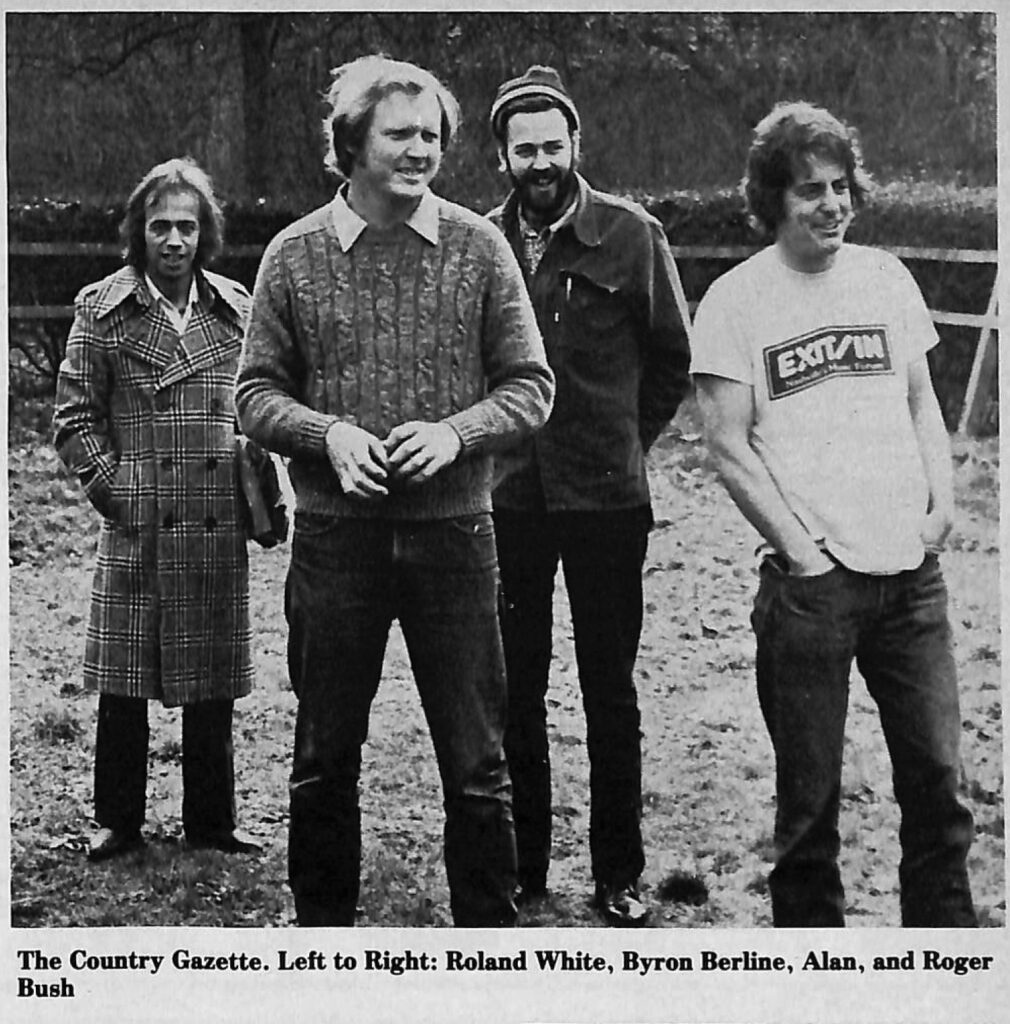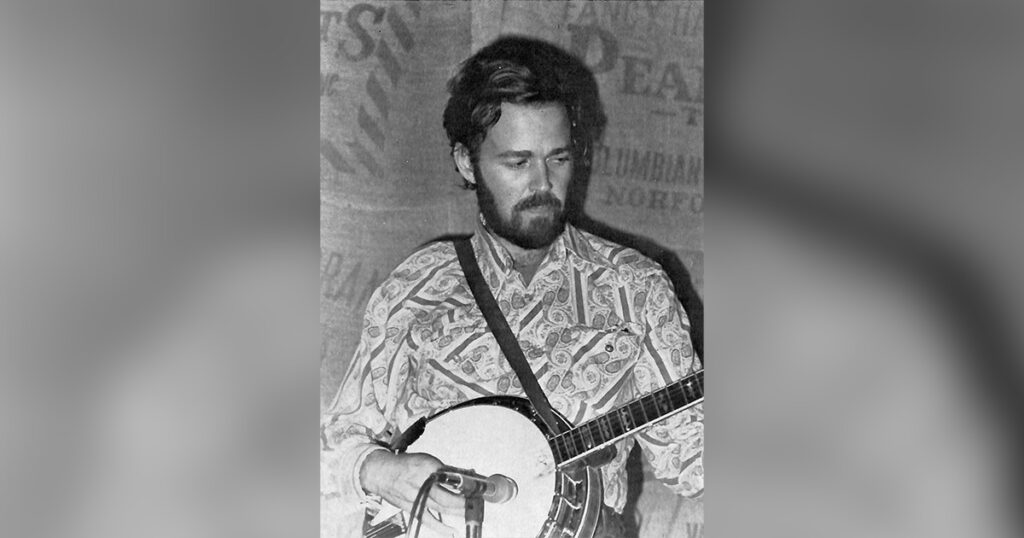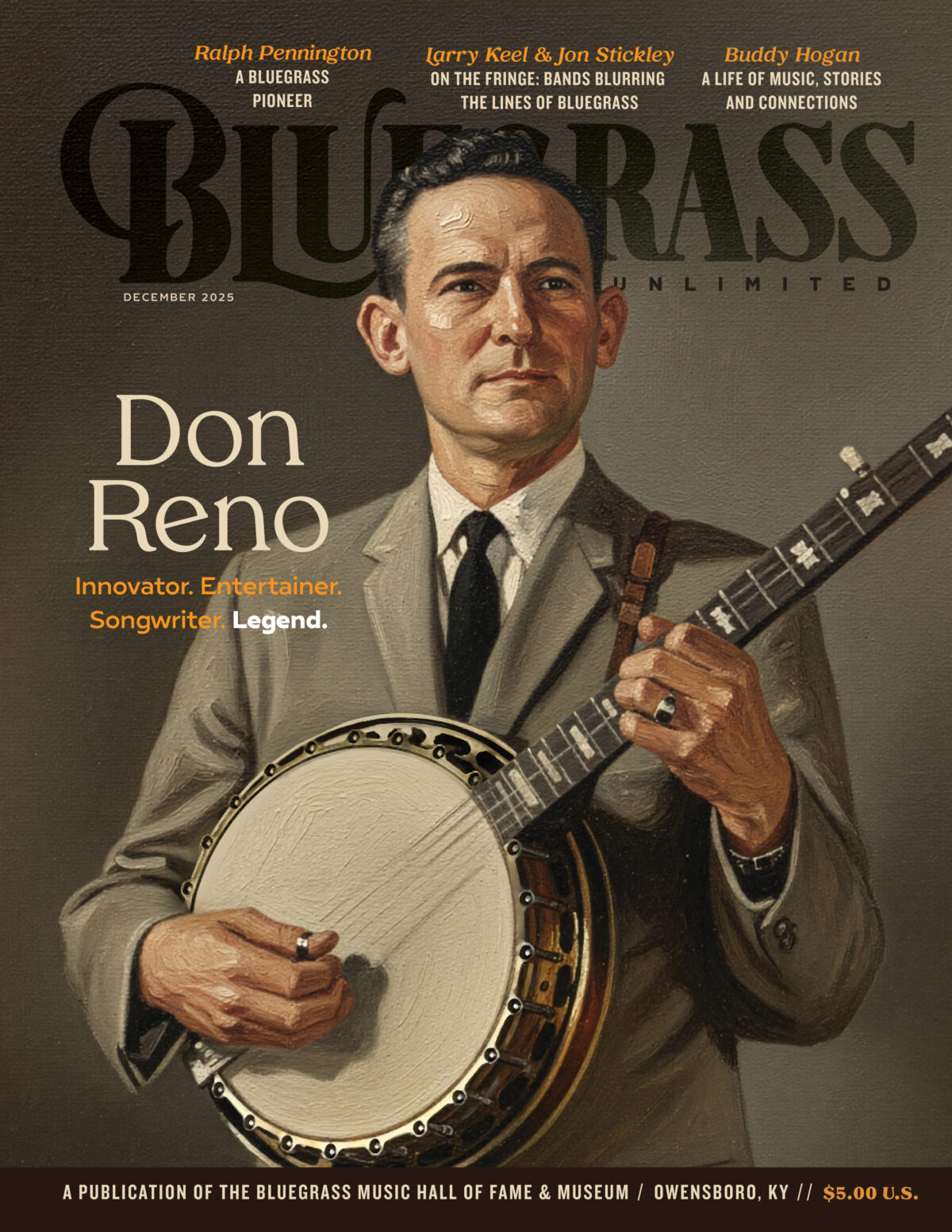Home > Articles > The Archives > Alan Munde
Alan Munde
Reprinted from Bluegrass Unlimited Magazine
October 1976, Volume 11, Number 4
Bluegrass banjo’s ever-widening popularity, both here and in Europe, has been greatly broadened through the innovative efforts of one 29 year old native of Norman, Oklahoma, Alan Munde. As an integral component of The Country Gazette for almost five years now, Al has more than aptly demonstrated his expert ability on the five-string, both within the confines of traditional bluegrass music, as well as in the newer and more experimental fringes of banjo picking. After serving an “apprenticeship” with Jimmy Martin’s Sunny Mountain Boys in Nashville through the late 1960’s and into the early ’70’s, Munde has since gone on to develop a versatile playing style which encompasses nearly every facet of contemporary bluegrass banjo picking. Always inventive in his approach to music, he has become a much-respected instrumentalist capable of delivering an exciting, hard-driving sound which is uniquely his own.
Out of a family including two older brothers and a younger sister, only Alan showed any genuine interest in music. After learning guitar as a teenager from a Pete Seeger instruction record, Al would frequent the nearby University of Oklahoma in Norman where folk music was enjoying a sudden, if short-lived, upsurge in popularity. It was there that he was initially exposed to the distinctive sound of the 5-string, and at about the age of 16, purchased his first banjo. “There wasn’t anybody around then to play with,” he remembers, “so I just frailed around on a cheap little banjo that I could beat on for about a year.”
Because of the overriding appeal of folk music around the Norman area during the early 1960’s, the chance of hearing any good bluegrass music, for Al, was greatly inhibited. Actually, it was not until Alan was given a Flatt and Scruggs “Foggy Mountain Banjo” album as a birthday gift, that he got interested and really began concentrating on 3-finger style picking.
Upon graduation from high school, Al entered the University of Oklahoma where he eventually earned a B.A. degree in Education. It was there that he first became acquainted with fiddler Byron Berline. At about that time (1965), Byron was performing with Ed Shelton on a local TV broadcast out of Oklahoma City, and Al would drive up there on occasion to pick with them. The influence of Ed Shelton upon Munde’s early development as a picker was, evidently, a very profound one. “I used to visit him and spend the night and play,” Al recalls, “and he’d show me how to do things. Ed did it different than most anybody else did it, I thought. But it always came out nice. Everything he had was worked out in a chord kind of thing.”
During their college years in Norman, Oklahoma, Alan and Byron Berline occasionally picked together as The Bluegrass Gentlemen, a group which also included musicians Albert Brown and Walter Hawkins. The band remained together in that form for a couple of years, during which time, Al laughingly recalls, “I don’t think we ever made a dime.” It was through Ed Shelton that Alan met three fine Dallas bluegrass pickers—Lonnie Kraft (guitar), Mitchell Lande (mandolin), and H.E. Williams (bass)—and the four of them joined forces to form The Stone Mountain Boys. Munde continued to play banjo for them for the remainder of his college years.
Soon after his graduation from the University of Oklahoma (and fortunately escaping the draft), Al headed for Nashville in October of 1969. By chance, it was there at one of the local jam sessions, that he had the opportunity to meet and pick with Jimmy Martin, who at the time, it seemed, was in the market for a new banjo player. Needless to say, not soon after, Al had landed his first full-time professional bluegrass job which, he states, “was the first group I ever made any money with.”

Munde’s association with Jimmy Martin lasted exactly two years, during which time three different albums where Al’s banjo picking can be heard were recorded. In October of 1971, he quit The Sunny Mountain Boys with plans to move out to the West Coast. It was at approximately that same time that Byron Berline and bass player Roger Bush began the initial efforts of organizing The Country Gazette back in Los Angeles.
Alan recalls: “I called Byron up and told him I was quitting and wanted to go out to California, and if anything came up, to have him give me a call. That was in September or October of ’71. So, about Christmas time, he called me back and said that he was getting this Burrito Brothers thing to go to Europe and would inhibited. Actually, it was not until Alan was given a Flatt and Scruggs “Foggy Mountain Banjo” album as a birthday gift, that he got interested and really began concentrating on 3-finger style picking.
Munde’s association with Jimmy Martin lasted exactly two years, during which time three different albums where Al’s banjo picking can be heard were recorded. In October of 1971, he quit The Sunny Mountain Boys with plans to move out to the West Coast. It was at approximately that same time that Byron Berline and bass player Roger Bush began the initial efforts of organizing The Country Gazette back in Los Angeles.
Alan recalls: “I called Byron up and told him I was quitting and wanted to go out to California, and if anything came up, to have him give me a call. That was in September or October of ’71. So, about Christmas time, he called me back and said that he was getting this Burrito Brothers thing to go to Europe and would I like to go and play the electric guitar and the banjo, and then after that was over, to come to California and be in The Country Gazette with him. Actually, they had even played some dates already as The Country Gazette with Herb Pederson one time and with Pat Cloud another time, but Byron and Roger were trying to keep things going…The Burrito Brothers’ tour sort of gave me the money and whatever it takes to go from Nashville to California.
“…Our first job was at Breda, Holland on January 1st, 1972, as part of The Flying Burrito Brothers act. We weren’t actually billed as The Country Gazette yet. The first time I ever met half the guys was in New York City, and then the first time I ever played with them was on the stage when we did the show.”
Upon completion of this first and highly successful European tour with The Burrito Brothers, Al and Byron, together with Roger Bush and guitarist-singer Kenny Wertz, went about the task of formally establishing The Country Gazette. They worked the summer of 1972 at Disneyland and in September of that same year, recorded their first album for United Artists—”A Traitor In Our Midst.” The release of the album was quickly followed with a promotional tour around the States, and in February of 1973. The Gazette was off to Europe again with The Burrito Brothers. However, as Alan pointed out, on this second tour they did not go as part of the Burrito Brothers band, but rather, as a separate supporting group.
The Gazette was extremely successful in Europe, particularly in Holland and England. Their first album had been released there, and two cuts from it—“Keep On Pushin’” and “Hot Burrito Breakdown”—had made the charts. “We played ten or twelve dates in Holland alone,” Al commented, “which was a lot for a country that’s 200 miles long and a hundred miles wide. It was a really good trip and we had a great time.”
The Gazette’s second album, “Don’t Give Up Your Day Job,” was recorded in the summer of 1973. In July, Kenny Wertz left the group and was replaced by Roland White. After the release of the album in September, The Gazette returned to Europe for a third tour, this time with the help of Roland White. Their third and most recent album was recorded live at McCabes in Santa Monica, California, and, as Al was quick to mention, “has been released in England, Holland—everywhere but here.”
More recently, Byron Berline left the group and has since organized his own band, Sundance, with the help of friends John Hickman, Alan Wald, Dan Crary and Jack Skinner. Replacing him in The Gazette is a fantastic fiddler hailing from Ft. Worth, Texas by the name of Dave Ferguson, whose playing is probably best known via The Stone Mountain Boys of Dallas. To nobody’s surprise, The Country Gazette has been off to Europe again, where they played festivals in Switzerland and the south of France, as well as performing some dates in Holland and England.
“I like performing with a group best of all,” Al Munde states, but since settling in the southern California area, he definitely has been no stranger to the recording studio. With some help in lining up gigs from Byron Berline and banjoist John Hickman, Al has been able to stack up a number of credits in the Los Angeles studios. Since 1971 his session work includes a number of movie soundtracks such as “Can Ellen Be Saved?,” “Bounty Man,” and Walt Disney’s production, “The Nashville Coyote.” While on tour in Europe, Al “sat in” on the recordings of Sari Schuwer (a popular Dutch vocalist), and England’s Brent Hayworth, and his banjo picking can be recognized on the highly played “Hummers” Mazda commercials.
In addition, Munde has cut two albums of banjo music. The first, entitled “Poor Richard’s Almanac,” was recorded in 1969 with the help of Sam Bush. The second, was recorded in Ft. Worth on the newly formed Ridgerunner label. The album is called “Alan Munde’s Banjo Sandwich” and features the back-up assistance of Roland White, Roger Bush, Dave Ferguson and Doc Hamilton. “There are some things on it I always wanted to do,” explains Alan, “a few slow pieces and some original stuff.”
Throughout his career, Alan Munde has continually shown an aversion to the categorical labels which seem to befall so many pickers today. It’s his belief that not only is it important and necessary for one to simply perfect his ability as a banjo player, but it is essential that he continue to grow musically as well. By its very nature, Munde’s flowing, innovative style is one that defies categorization; his integrity as a musician, as well as his proficiency as an instrumentalist, has rightfully earned him the respect of both fans and professionals alike.

